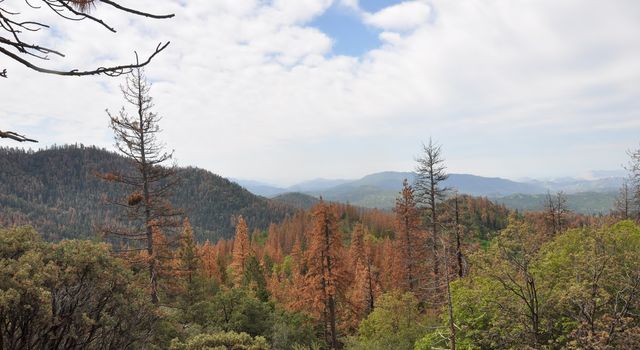
Dead and dying ponderosa (Pinus ponderosa) and sugar (P. lambertiana) pine on the Hume Lake Ranger District, Sequoia National Forest, California.
Credit: USDA Forest Service
February 16, 2019 - By Jonathan Gudel - Although former Governor Edmund G. Brown rescinded the drought state of emergency order in 2017, tree mortality remains a lingering issue throughout forests in California. Only Fresno, Kings, Tulare and Tuolumne counties remained in a drought emergency.
However, the U.S. Forest Service announced that an additional 18 million trees, mostly conifers, died in California since fall 2017. More than 147 million trees have died across 9.7 million acres of federal, state, local and private lands in California since the drought began in 2010. The estimated number of dead trees in California from 2010 to 2016 was 102 million.
“The Forest Service is focused on increasing the pace and scale of ecological restoration – this includes thinning dense areas to promote healthy forests that are more resilient to wildfires, drought and bark beetle outbreaks,” said Randy Moore, Regional Forester of the USDA Forest Service, Pacific Southwest Region. “The Forest Service completed approximately 313,000 acres of restoration in 2018, which included over 63,000 acres of prescribed fire – the largest number recorded since the National Fire Plan was implemented in 2001.”
Through the California Disaster Assistance Act, Cal OES has contributed $12.2 million towards the removal of dead and dying trees while assisting public agencies in the 10 high hazard counties.
“The long term impacts on our water, air and wildlife that will follow wildfires fueled by these dead trees must also be considered and mitigated,” said Tina Walker, Cal OES Recovery Infrastructure Branch Chief.
Since 2016, federal, state, and local partners have felled 1.5 million dead trees, primarily those posing the highest hazards to life and property. The drought was marked by extraordinary heat, with 2014, 2015 and 2016 as California’s first, second and third warmest years, respectively, in terms of statewide average temperatures.
While the 2016-2017 winter officially ended California’s drought, below-average precipitation recorded in 2017-2018 slowed the recovery of the state’s surviving trees. Dead trees continue to pose a significant hazard to people and critical infrastructure, mostly centered on the west side of the southern Sierra Nevada range; however, other forested areas throughout the state and at higher elevations have also been impacted.
“It is encouraging that the rate of mortality slowed in 2018,” CAL FIRE Director Thom Porter said. “However, 18 million trees are an indication that the forests of California are still under significant stress. The stress of drought, insects, disease, and prolific wildfire will continue to challenge the resilience of the state’s forests. In accordance with the 2019 Strategic Fire Plan for California, CAL FIRE will continue to increase the pace and scale of fuels and forest management project work and grants. California’s Forest Management Task Force will continue to coordinate the statewide multi-agency response.”
The Forest Management Task Force was created in May 2018 to help combat tree mortality, increase the ability of forests to capture carbon, and systematically improve forest management between state, local, federal and tribal agencies. On January 8, during his first full day in office, Governor Gavin Newsom announced his commitment to forest health and called for a five-year, $1 billion forest management plan in his 2019-2020 state budget proposal.
Source: Cal OES









